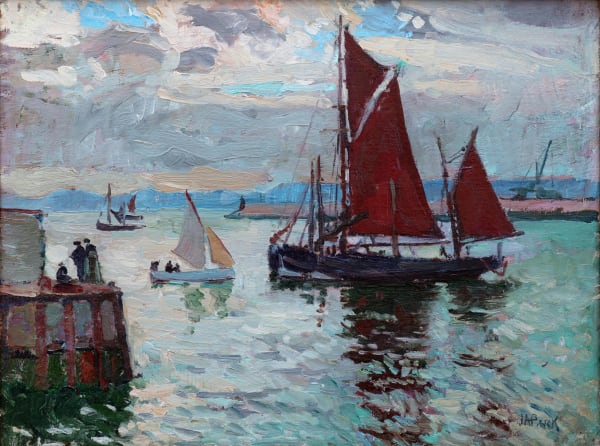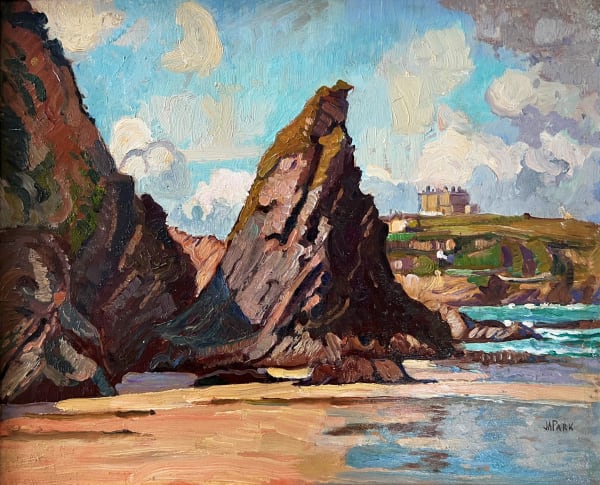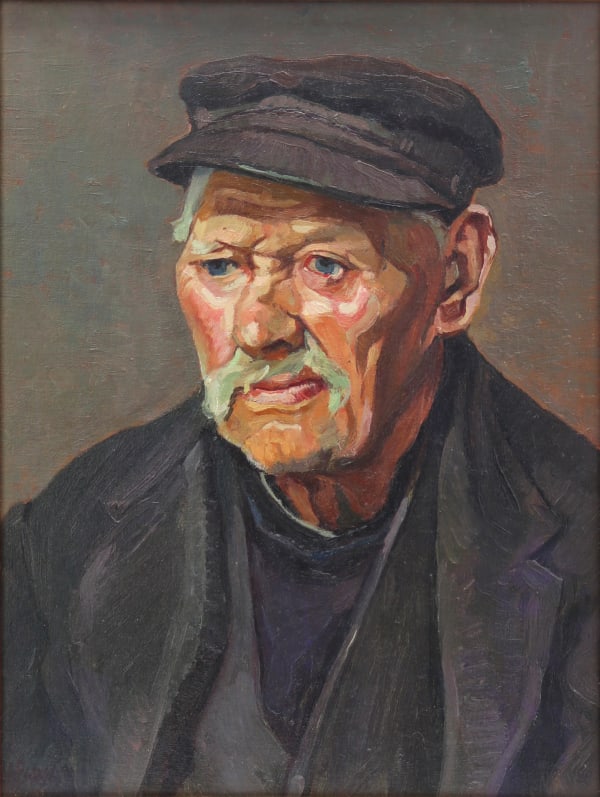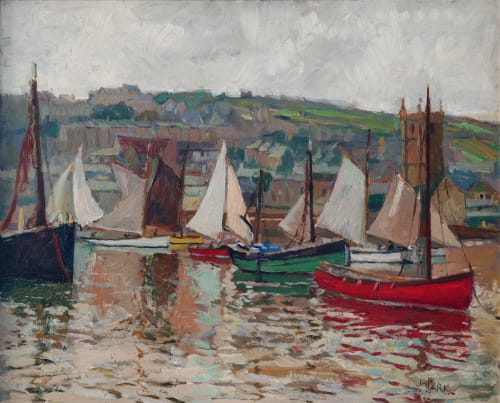John Anthony Park 1878-1962
-
 John Anthony ParkRed Sails, c. 1920Oil on canvas30.5 x 40.6 cm (12 x 16 ins.)
John Anthony ParkRed Sails, c. 1920Oil on canvas30.5 x 40.6 cm (12 x 16 ins.)
Framed: 43.2 x 53.3 cm (17 x 21 ins.)View full details -
 John Anthony ParkYachts in St Ives Harbour , c. 1935Oil on panel32.8 x 40.5cm (12 15/16 x 15 15/16ins.)
John Anthony ParkYachts in St Ives Harbour , c. 1935Oil on panel32.8 x 40.5cm (12 15/16 x 15 15/16ins.)
Framed: 51.6 x 59.3cm (20 5/16 x 23 1/3ins.)View full details -
 John Anthony ParkQueen Bess Rock, Bedruthan StepsOil on board34 x 41cm (13 3/8 x 16 1/8in).
John Anthony ParkQueen Bess Rock, Bedruthan StepsOil on board34 x 41cm (13 3/8 x 16 1/8in).
Framed: 45.7 x 53.4cm (18 x 21 in)View full details -
 John Anthony ParkBishop's Rock, NewquayOil on panel34 x 43cm (13 3/8 x 16 15/16in).
John Anthony ParkBishop's Rock, NewquayOil on panel34 x 43cm (13 3/8 x 16 15/16in).
Framed 46 x 53.7 (18 1/8 x 21 1/8 in).View full details -
 John Anthony ParkBeached, St Ives HarbourOil on board27.3 x 38.1 cm (10 3/4 x 15 ins.)
John Anthony ParkBeached, St Ives HarbourOil on board27.3 x 38.1 cm (10 3/4 x 15 ins.)
Framed: 45.3 x 56.1 cm (17 3/4 x 22 ins.)View full details -
 John Anthony ParkSt Ives Fisherman, 1929Oil on canvas44.5 cm x 34.5 cm (17.5 x 13.6 ins.)
John Anthony ParkSt Ives Fisherman, 1929Oil on canvas44.5 cm x 34.5 cm (17.5 x 13.6 ins.)
Framed: 59 x 48.7 cm (23.2 x 19.2 ins.)View full details
".... one of the best of English colourists and unsurpassed as a painter of light: He painted like an angel – simply cathedrals of light." Sven Berlin on John Anthony Park.
John Anthony Park was born in Preston in 1878 into a working-class family and as a young boy worked in Lancashire cotton mills. From the age of 8 he also helped his father in his painting and decorating business and from there blossomed an early interest in painting.
In the latter half of the 1890s, a 19-year-old Park moved to St Ives. Park had received no formal training in fine art prior to St Ives, but there had the good fortune to meet Julius Olsson who gave the young man free tuition and was rewarded with an eager and intuitive pupil. From 1902 to 1904 Park continued his studies under Olsson and Algernon Talmage in the St Ives School of Painting and became the school’s star pupil.
In 1905 Park had 3 St Ives harbour scenes accepted by the Royal Academy: 'Summer evening', 'Low tide' and 'The bay, cloudy day'. This acknowledgement of his significant acumen as a young artist and the encouragement of his mentor, Julius Olsson, propelled Park to Paris in 1905. There he studied at The Académie Colarossi under Auguste Delecluse and was a contemporary of Modigliani.
In Paris, Impressionism and Post Impressionism were gaining wider public acclaim and Park’s life’s work clearly illustrates the influence of his Parisian training and exposure to the Impressionists and contemporary Post Impressionists. Park’s work is deftly and swiftly executed with bold strokes from fully charged bristle brushes and a wonderful sense of the spectrum of colours to be perceived in light and shadow. In Park’s mature paintings of St Ives harbour; in his embrace of a rich palette of colour and rapid working we can perceive the influence of the paintings of Paris life along the Seine by amongst others, Claude Monet and Camille Pissarro and in his short almost stippling brush strokes capturing that famous St Ives shimmer, perhaps even a recollection of Georges Seurat.
In 1906 Park returned to England where he painted in London on the Thames and along the south coast including Plymouth. In 1911 he travelled to Concarneau in Brittany which, like St Ives, was a harbour town and base for a flourishing new wave of en plein-air artists. During the war he served in the East Surrey Regiment in France.
In 1919 he married Peggy and the couple moved to Brixham and then by 1921, on to St Ives settling down in their long-term home, 3 Bowling Green in 1923. That same year Park became a member of The Royal Society of Oil Painters. In the Show Day of 1924 (an annual pre-Royal Academy Summer Exhibition event in St Ives), Park exhibited Drying Sails, another St Ives work, Herring Time St Ives, and a third work, Souvenir from France, depicting the entrance to the harbour of La Rochelle. Park was a well-established artist when he became a founding member of the St Ives Society of Artists in 1927, representing probably their best-known member and most highly rated artist.
John Park enjoyed a pint and was a regular in Cornwall’s oldest pub, the Sloop on the harbour front at St Ives where a room full of his paintings was regularly on show. His St Ives studio was conveniently nearby.
In 1932 Park became a member of the Royal Society of British Artists. He was a regular exhibitor at the Paris Salon and was awarded their Gold Medal in 1934. Commenting upon the importance of Park in the chronology of St Ives painters the Borlase Smart John Wells Trust says of the painter, 'John Park and Borlase Smart are the two most important links between the more traditional St Ives artists and the modernists. His impressionist style was recognised by many of the modernists as the most advanced of the traditional painters, with Sven Berlin rating him one of the best of English colourists and unsurpassed as a painter of light: “He painted like an angel – simply cathedrals of light."'
Park’s success in St Ives led him to move to London in 1933 where his studio in Maida Vale was close to that of Dorothea Sharp. Throughout the 30s Park travelled extensively including throughout Italy and the Spanish Balearics but returned to the West Country for his favourite subjects. ‘Snow Falls on Exmoor’ 1939, was bought for the Tate Gallery under the terms of the Chantry Bequest in 1940. Today many Park works of this period, mainly river landscapes, adorn public collections including 'Heart of Exmoor' in the Salford Museum & Gallery, 'This England' in the Manchester Art Gallery and 'Spring on the Stour' in the Southampton City Art Gallery.
In 1940 St Ives drew the artist back on a more permanent basis and he remained there until 1957 when aged 77, and upon the passing of his wife, he moved back to his birthplace, Preston. John Park died in 1962.
Park’s legacy is to be recalled as a wonderful colourist; a St Ives artist whose work represents a bridge between the en plein-air artists of the late 19th century and the mid-20th century movement that was to later dominate St Ives, and fine art across the western world. In later life the artist wrote ‘“Colour is everything. Anyone can be taught line, but you cannot teach a feeling for colour.”
Wormleighton, Austin (1998) MORNING TIDE. John Anthony Park and the Painters of Light, St Ives 1900-1950, Stockbridge Books








